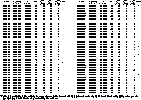We present subarcsecond radio positions and core radio flux densities for all 2,127 sources appearing in both the Green Bank 5GHz and in the ROSAT All-Sky Survey catalogs. The accuracy of the positions is sufficient to give unique optical identifications for the X-ray- and radio-emitting sources (B96).
This RGB sample is comprised principally of radio-loud AGN. It is complete
and unbiased with well-defined selection criteria: X-ray flux above the RASS
sensitivity limit (which depends only on ecliptic latitude), arcminute-scale
radio flux density above ![]() at 5GHz, and declination between
at 5GHz, and declination between
![]() and
and ![]() .
.
The radio emission of the RGB sample is found to be more core-dominated than
ordinary radio galaxies but less than strongly beamed BL Lac objects, which
suggests it consists primarily of moderately beamed AGN. Using simple beaming
models, the typical RGB object is shown to be dominated by a jet oriented at an
intermediate angle to the line-of-sight (![]() ). The X-ray beaming properties are not
tightly constrained, but exclude the extremes of purely isotropic emission and
of X-ray emission which consists of a significantly higher fraction of beamed
flux than is characteristic of the radio emission.
). The X-ray beaming properties are not
tightly constrained, but exclude the extremes of purely isotropic emission and
of X-ray emission which consists of a significantly higher fraction of beamed
flux than is characteristic of the radio emission.
Note in press: After submission of this paper, we discovered a possible systematic position error in a very small subset of sources. In particular, the sources RGB J0131+005, RGB J0139+178, RGB J0143+129, RGB J0157+235A, RGB J0232+202, RGB J0233+024A, RGB J0243+171, RGB J0256+035, RGB J0303+059, RGB J0308+104, RGB J0312+243A, RGB J0312+242C, and RGB J0314+063 were all observed in our ``c" epoch VLA runs and show large systematic offsets with respect to sources found in the NVSS survey. We re-examined these sources and found the position reported in the tables is accurate given our data, but that the noise on these fields before any CLEAN-ing is abnormally high. We thank Dr. Alastair Edge for pointing out this discrepancy.
Notes to Table 2
1545+646A: More than 3![]() from GB position
from GB position
1545+646B: More than 3![]() from GB position
from GB position
1547+208: Core radio flux from Miller et al. (1993)
1549+026: Core radio flux from Murphy et al. (1993)
1550+113: Core radio flux from Hintzen et al. (1983)
1604+012: Core radio flux from Baum & Heckman (1989)
1608+104: Core radio flux from Murphy et al. (1993)
1609+179: Core radio flux from Hutchings et al. (1988)
1617+350: More than 3![]() from GB position
from GB position
1620+176: Core radio flux from Hintzen et al. (1983)
1625+268: Core radio flux from Feigelson et al. (1984)
Notes to Table 3
0242+083: More than 3![]() from GB position
from GB position
Notes to Table 4
0140+087: Possibly Spurious Source; See Condon et al. (1994)
0205+648: Extended Source
0247+187: Extended Source
0317+415: Confused Field - Possibly Spurious Source
0528+344: Extended Source
0533+210: Confused Field - Possibly Spurious Source
0535+222: Confused Field - Possibly Spurious Source
0641+080: Extended Source
1232+123: Confused Field - Possibly Spurious Source
1728+086: Confused Field - Possibly Spurious Source
1852+006: Extended Source (known SNR)
1859+071: Confused Field or Extended Source
2015+386: Confused Field - Possibly Spurious Source
2212+589: Extended Source
2302+587: Extended Source
2323+584: Confused Field - Possibly Spurious Source
1

Table 2: Radio source properties (sample page)

Table 3: Radio source properties: low resolution data (sample page)

Table 4: Radio source properties: empty fields
Acknowledgements
We wish to thank C. Palma for help with the data reduction at Penn State. This work was partially supported by NASA under Grant NAGW-2120. We have made use of the NASA/IPAC Extragalactic Database, operated by the Jet Propulsion Laboratory, California Institute of Technology, under contract with NASA.